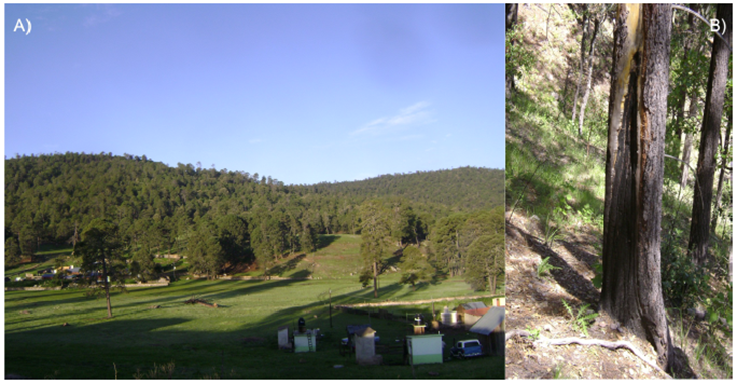Introduction
Fires are one of the most important disturbance factors with ecological, economic, social and political impacts on forest ecosystems (Pyne, Andrews, & Laven, 1996); however, fire is found naturally in many ecosystems and the presence of this element is essential for most of them (González, Schwendenmann, Jiménez, & Himmelsbach, 2007).
Fires play an important role in forest ecosystems, as they contribute to the mineralization of organic matter, participate in various nutrient cycles and can promote tree growth when the fire is of low intensity, thanks to the natural pruning that it propitiates (Rodríguez, 2006). Among the negative impacts are the destruction of the ecosystem and the migration of fauna, causing the people who depend on this resource to be economically affected (Lloret, 2004).
Climate change has changed the behavior of forest fires by altering ecosystems. In several regions of the planet, fires of greater area, duration, intensity and severity have been observed, caused by a greater accumulation of combustible loads, higher temperatures with lower relative humidity and longer droughts (Rodríguez, 2012). Climate variability is significantly modulated by ENSO (El Niño Southern Oscillation) globally (Stahle et al., 1998) and regionally (Cerano, Villanueva, Valdez, Arreola, & Constante, 2011), as in the case of northern Mexico. ENSO in its warm phase, El Niño, favors humidity conditions in the north of Mexico and drought in the center (Fulé, Villanueva-Díaz, & Ramos-Gómez, 2005; Heyerdahl & Alvarado, 2003), and vice versa, the cold phase, La Niña, is associated with drought conditions in the north and humidity in the center (Magaña, Vázquez, Pérez, & Pérez, 2003). Some fire reconstruction studies for northern Mexico report significant influence of ENSO in its cold phase (La Niña) on historical fire frequency (Cerano, Villanueva, & Fulé, 2010; Fulé et al., 2005; Heyerdahl & Alvarado, 2003).
Each region, ejidal community or forest area presents different ecological conditions; therefore, it is impossible to generalize the ecological principles of fire management. In this sense, it is important to delimit each unit of study, due to existent variability in climatic terms (temperature, precipitation and relative humidity), topography and physiography (exposure and slope), and vegetation (Whelan, 1995). Knowledge of forest fire regimes by region and forest type is essential, as it provides technical elements for developing more efficient fire prevention and management programs. For this reason, this study has a three-fold objective: 1) reconstruct historical fire regimes in the pine-oak forests of the community of Charcos, Mezquital, Durango, 2) determine the seasonal timing of fires and 3) analyze the influence of rainfall and ENSO on historical fire frequency.
Materials and methods
Study area
The study was carried out in a pine-oak forest in the community of Charcos, Mezquital municipality, Durango (Figure 1). The site is located in the Sierra Madre Occidental mountain range, at an average elevation of 2,760 m. The plant community is dominated by the species Pinus durangensis Martínez, Pinus arizonica Engelm., Pinus ayacahuite Ehrenb. ex Schltdl. and Quercus sp. The topography of the area is formed by a plateau and pronounced slopes (Instituto Nacional de Estadística y Geografía [INEGI], 2014). According to the climatic classification of García (2004), the climate is of the humid temperate type with summer rains (Cw1).
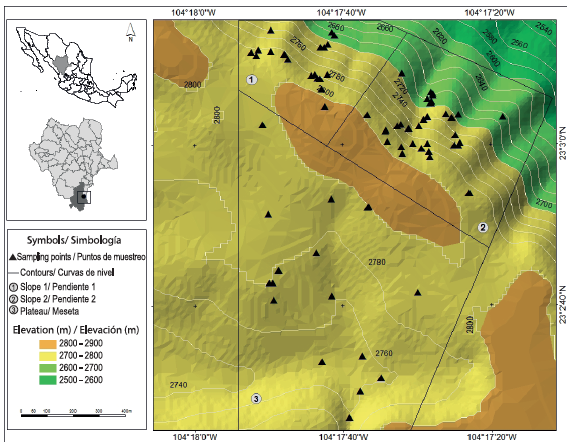
Figure 1 Geographic location of study sites in the forests of the community of Charcos, Mezquital, Durango.
The study area was divided into three sites: 1) the Plateau site, a flat area with a slope of not more than 2 % and an area of approximately 80 ha, 2) the Slope 1 site (S1), which has a wetter condition with an area of 20 ha and 3) the Slope 2 site (S2), which has a drier condition with an area of 17 ha. The S1 and S2 sites have a recorded slope ranging from 15 to 45 %.
Field method
Samples were selected using a selective sampling system, considering only the longest-lived specimens and those with the highest number of fire records (Figure 2). Using a chainsaw, 78 partial samples were extracted from P. durangensis, P. arizonica, P. ayacahuite, Pinus teocote Schltdl. & Cham. and Pseudotsuga menziesii (Mirb.) Franco; 57 samples (73 %) of live trees and 21 (27 %) of dead trees (standing, lying and stumps). Each sample was georeferenced (GARMIN GPSMAP 64 GPS, Taiwan) and the information corresponding to the characteristics of the microsite and the collected trees was recorded.
Sample preparation and analysis in laboratory
Samples were dried and polished with 60 to 1,200 grit sandpaper to better visualize the xylem structures (growth rings). Each of the samples was predated by comparing growth patterns, using a stereoscopic microscope with a 10X magnifying glass (Stokes & Smiley, 1995). The width of each ring was measured with a VELMEX (USA) measurement system with 0.001 mm accuracy. The quality of the measurement and dating was verified with Program COFECHA (Holmes, 1983).
The seasonal timing of fires was determined by defining the location of the scar within the annual growth. Based on the methodology proposed by Baisan and Swetnam (1990), the EE (early earlywood), ME (mid-earlywood), LE (late earlywood), L (latewood) and D (dormancy) categories were established. The seasonal timing of the fire was defined by grouping the categories into the spring (D + EE) and summer (ME + LE + L) periods (Grissino-Mayer, 2001).
Data analysis
Statistical analysis of historical fire frequency was performed using FHX2 software version 3.2 (Grissino- Mayer, 2001). Statistics generated by the program were: mean fire interval (MFI), maximum and minimum fire intervals, and Weibull median probability interval (WMPI) (Grissino-Mayer, 2001). For each statistic, three filters were considered: 1) all scars, 2) 10 % or more of the scars recorded in all samples, and 3) 25 % or more of the scars recorded in all samples (Cerano et al., 2010). The last filter allowed determining the intervals of the most extensive and severe fires.
The relationship between climate variability and fires was determined using FHX2 software’s Superposed Epoch Analysis (SEA) (Grissino-Mayer, 2001). As a proxy of the climate, a chronology of P. durangensis generated for this region of the state of Durango (Díaz-Ramírez, Villanueva-Díaz, & Cerano-Paredes, 2016) and ENSO Niño 3.4 indexes were used (Trenberth, 1997). Both variables were compared during the fire, five years before and two years after it. To evaluate the statistical significance of the SEA analysis, the confidence interval (95 %) was calculated using the bootstrapped distribution of the climatic data with 1,000 replicates.
Results and discussion
Of a total of 78 samples with fire scars, 21 (27 %) from dead trees and 57 (73 %) from live ones, 75 samples (96 %) were dated; the rest could not be dated due to a high degree of deterioration by rot and periods of very small rings that did not allow setting the dates of the scars with accuracy. The selected trees presented a wide range of diameter classes (19 to 73 cm), with a mean of 44 cm. Fire history was reconstructed for the last 268 years, covering the period 1746-2013 (Figure 3). A total of 535 scars were analyzed, the year 1779 represented the first fire record and the year 2012 the most recent fire. For the Plateau site, fire history was rebuilt for the last two centuries. In this area, lower fire variability over time was determined. At the S1 site, fire history was generated for the past 120 years; although the dated trees had recorded ages of up to 200 years, no evidence of older fires was recorded. At the S2 site, fire history was reconstructed for 235 years (1779-2013); in the period from 1850 to 1976 a higher frequency of fires was observed. After 1976, a longer time interval between fires was observed, which could lead to a greater accumulation of fuels and, consequently, the occurrence of more extensive and severe fires (Figure 3); these events were recorded in 90 % of the samples. The Plateau site, unlike the S1 and S2 sites, had trees with a high number of fires, many of them recorded only at this site. This is attributable to anthropogenic issues, since it is a site that has been used for grazing purposes, due to its low slope (2 %) and pasture dominance, where the use of fire to promote regrowth is very common.
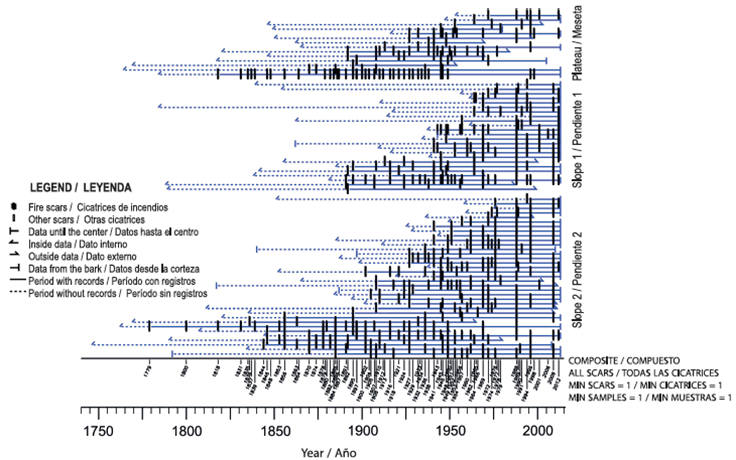
Figure 3 Historical fire frequency in the forests of the community of Charcos, Mezquital, Durango, considering all scars. The blue lines represent the longevity of the analyzed trees. The vertical lines highlighted in black represent the fires recorded per tree over time; the formation of a continuous line indicates an extensive fire. The specific year in which each of the fires was recorded is shown on the secondary axis of the abscissas.
The Plateau and Slope 1 sites are areas that have been under use, to which the greater number of live trees that are barely 100 years of age is attributed. The oldest records come from dead trees or stumps left behind after management activities. The few old trees found at the Plateau site correspond to a silvicultural treatment called seed-tree cut. In the case of the Slope 2 site, the presence of longer-lived live trees is due to the presence of P. menziesii, a protected species, which has possibly limited more intensive use and saved a larger number of old individuals.
Seasonality of fires
Table 1 reports the seasonality of the fire scars. No events were detected in dormancy or latewood seasons; 471 (92.2 %), 31 (6.1 %) and 9 (1.8 %) scars were recorded in the early, mid- and late earlywood seasons, respectively. Based on the methodology proposed by Grissino-Mayer (2001), fires were categorized into two periods: 92.2 % in spring (D + EE) with a total of 471 scars and 7.8 % in summer (ME + LE + L) with 40 scars. Similar results were reported in studies conducted in the Sierra Madre Occidental, where more than 80 % of the fires were categorized in the spring season (Cerano et al., 2010; Heyerdahl & Alvarado, 2003; Fulé et al., 2005). In central Mexico, a study in high mountain forests in the Pico de Orizaba, Veracruz, reports 95.2 % of fires in the spring (Yocom & Fulé, 2012) and in the Sierra de Manantlán, Jalisco, 95 % of reconstructed fires occurred during the spring (Cerano et al., 2015). The fires at this time occur between the last days of April and the beginning of June; this is related to a dry period, to which the highest number of fires is attributed. Summer fires are recorded between the last days of June and the first days of September, when there is higher humidity and, therefore, less fire frequency (Swetnam, Baisan, & Kaib, 2001).
Table 1 Categorization of the seasonality of fire scars in a pine-oak forest in Charcos, Mezquital, Durango.
| Scars | Total | Determined seasons | Undetermined seasons | D | EE | ME | LE | L | Spring fires | Summer fires |
| Number | 535 | 511 | 24 | 0 | 471 | 31 | 9 | 0 | 471 | 40 |
| Percentage (%) | 100 | 95.7 | 4.3 | 0 | 92.2 | 6.1 | 1.8 | 0 | 92.2 | 7.8 |
D: dormancy, EE: early earlywood, ME: mid-earlywood, LE: late earlywood.
Historical fire regimes
For the three study sites (Plateau, S1 and S2), very similar MFIs were reconstructed: 3.0 years considering all scars and 6.0 years for the most severe fires (Table 2). In the composite analysis of the three areas, considering all scars, an MFI of 2.0 years and a WMPI of 1.8 years were determined. In the case of 10 % of scars recorded in all samples, the MFI was 3.2 years with a WMPI of 2.9 years, while for 25 % of recorded scars an MFI and WMPI of 7.0 and 5.9 years, respectively, were determined (Table 2).
Table 2 Distribution of mean fire frequency intervals for the pine-oak forest in the community of Charcos, Mezquital, Durango.
| Site | Period of analysis | Category of analysis | MFI | Minimum frequency interval | Maximum frequency interval | WMPI |
| Plateau | 1892-2013 | All scars | 2.6 | 1 | 11 | 2.3 |
| ≥ 10 % scars | 3.3 | 1 | 16 | 2.7 | ||
| ≥ 25 % scars | 6.0 | 1 | 19 | 5.0 | ||
| Slope 1 | 1891-2013 | All scars | 2.9 | 1 | 9 | 2.7 |
| ≥ 10 % scars | 3.4 | 1 | 12 | 3.1 | ||
| ≥ 25 % scars | 6.7 | 1 | 16 | 5.9 | ||
| Slope 2 | 1856-2013 | All scars | 2.8 | 1 | 9 | 2.6 |
| ≥ 10 % scars | 3.8 | 1 | 13 | 3.4 | ||
| ≥ 25 % scars | 6.6 | 2 | 14 | 6.2 | ||
| Composite | 1885-1976 | All scars | 1.9 | 1 | 4 | 1.8 |
| ≥ 10 % scars | 2.6 | 1 | 6 | 2.6 | ||
| ≥ 25 % scars | 6.2 | 1 | 20 | 5.0 | ||
| Composite | 1977-2013 | All scars | 2.7 | 1 | 9 | 2.3 |
| ≥ 10 % scars | 4.8 | 2 | 8 | 4.6 | ||
| ≥ 25 % scars | 8.0 | 3 | 13 | 7.6 | ||
| Composite | 1885-2013 | All scars | 2.0 | 1 | 9 | 1.8 |
| ≥ 10 % scars | 3.2 | 1 | 12 | 2.9 | ||
| ≥ 25 % scars | 7.0 | 1 | 20 | 5.9 |
MFI: MFI: Mean fire interval, WMPI: Weibull median probability interval.
A study carried out in La Michilía, Durango, reports an MFI of 4.0 to 6.0 years, superior to that reconstructed in this work; however, when considering the most severe fires, the MFI was similar (6.0 years) (Fulé & Covington, 1999). Heyerdahl and Alvarado (2003) report MFIs similar to those reconstructed in the present study (3.0 to 6.0 years), for seven sites in the Sierra Madre Occidental distributed from north to south in the state of Durango. Cerano et al. (2010) reported higher MFIs when considering all scars and the most severe fires (6 and 13 years, respectively) in Cerro Mohinora, Chihuahua.
The pine-oak forest in the community of Charcos showed an MFI less than or equal to that of other sites when considering all scars. The forest also showed MFIs similar to that of other sites in northern Mexico when considering the most severe fires (25 % of scars or more), a condition attributable to climatic variability modulated by large-scale climatic phenomena such as ENSO (Stahle et al., 1998).
In contrast to some studies conducted in the state of Durango (Fulé & Covington, 1999; Heyerdahl & Alvarado, 2003), fire frequency in the forest of the community of Charcos presents an uninterrupted frequency; however, severity increased after the 1970s (Figure 3), as a result of a longer time interval between fires and greater fuel accumulation. The amplitude of fire frequency intervals indicates an increase in the accumulation of fuels (leaves, grasses, shrubs and branches), both in quantity and continuity, which is likely to cause more severe fires, particularly when this condition is combined with years of drought (Skinner, Burk, Barbour, Franco-Vizcaíno, & Stephens, 2008). The change in fire frequency was observed after 1976, as fire activity was almost completely interrupted until 1988. The fuel accumulation lasted for 12 years, which, when synchronized with an ENSO event in its La Niña cold phase (1988), led to a significant decrease in precipitation for the Sierra Madre Occidental region (Cerano et al., 2012) and gave way to one of the most expensive fires. A similar condition was rebuilt for the years 1996, 2009 and 2012.
The historical frequency of fires shows the importance of their continuity; otherwise, the resulting fuel accumulation favors high-intensity fires with severe impacts on forests by modifying the structure, composition of species and their reproduction strategies (Rodríguez & Fulé, 2003).
Climate-fire relationship
The SEA analysis determined that there is no significant (P > 0.05) influence of regional climate variability and ENSO events on historical fire frequency; however, reconstructed fires are associated with years of below-average precipitation values (Figure 4A) and negative ENSO values (Figure 4B) indicating a drought condition. By contrast, no fires were recorded in the presence of positive or significant (P < 0.05) moisture conditions.
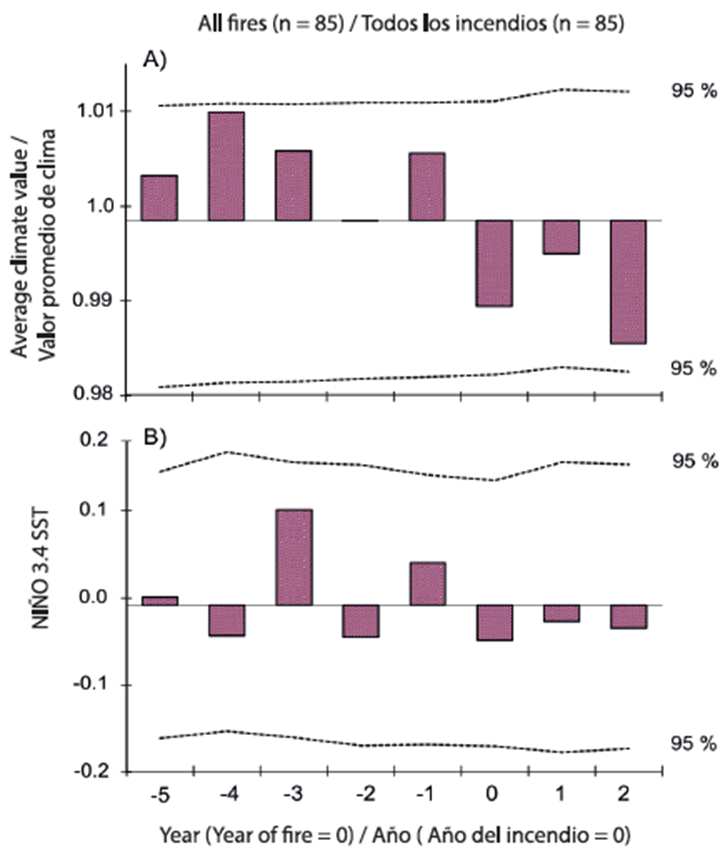
Figure 4 Superposed Epoch Analysis showing the climate-fire relationship (n = 85) in Charcos, Mezquital, Durango. All fire scars were associated with regional climate variability (regional chronology) and El Niño 3.4 indices, estimates of the variability of the ENSO phenomenon (El Niño Southern Oscillation). The year of the fire is indicated by “0,” conditions five years prior to the fire (negative values) and two years after the fire (positive values). The dotted upper and lower line represents the confidence interval.
Figure 5 shows that there is high variability in fire frequency between sites; however, for specific years, the most extensive and intense fires have affected the entire study area, regardless of topography and exposure conditions. In general, the most extensive fires are related to severe droughts reported in the state of Durango (Cerano et al., 2012; Cleaveland, Stahle, Therrell, Villanueva, & Burns, 2003). Although there is no significant (P > 0.05) relationship between climate and fires, the most extensive events (2012, 2009, 1996, 1988, 1972, 1969, 1962, 1953, 1945) are associated with ENSO in its cold phase, La Niña (Gergis & Fowler, 2009), a phase associated with reduced rainfall (drought) in northern Mexico (Cerano et al., 2012). For the last 45 years (1969-2013), six extensive and intense fires, five of which coincide with La Niña events, were rebuilt. A similar behavior in which fires were not significantly (P > 0.05) related to ENSO events, but in specific years harmonized with the incidence of ENSO and drought, have been reported for the La Michilía Biosphere Reserve, Durango (Fulé & Covington, 1999) and the Sierra de Manantlán Biosphere Reserve, Jalisco (Cerano et al., 2015). By contrast, other sites in northern Mexico have shown a significant (P < 0.05) relationship between reduced rainfall and fire occurrence (Cerano et al., 2010; Fulé et al., 2005; Heyerdahl & Alvarado, 2003), and between ENSO in its La Niña phase and historical fire frequency (P < 0.05) (Cerano et al., 2010; Fulé et al., 2005; Heyerdahl & Alvarado, 2003; Yocom et al., 2010).
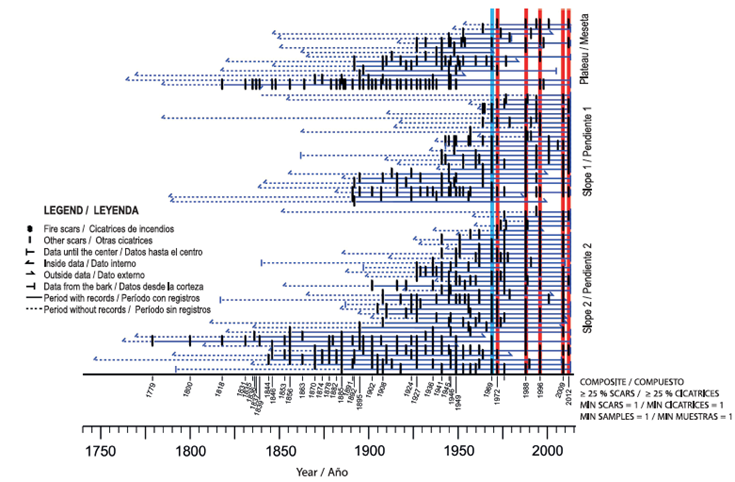
Figure 5 Historical fire frequency showing the most extensive events (25 % or more of the scars recorded in all samples) in Charcos, Mezquital, Durango. The most extensive reconstructed fires after 1976 were associated with ENSO events. In the last 45 years (1969-2013) six intense fires were rebuilt, five of which correspond to La Niña events (lines highlighted in red) and one to El Niño (vertical line in blue).
In general, the results indicate that fire frequency is due to both anthropogenic and climatic or natural issues. The amplitude in fire frequency after 1976 can be attributed to greater forest protection. In the case of the Plateau site, samples with a high number of fires, most of which do not have synchrony with other events inside or outside the site, were observed; these are very localized fires that may have been caused by the influence of man. By contrast, the most extensive and severe events recorded in the three areas (high synchrony) are positively related to drought conditions and La Niña events, which are due to climatic variability or non-anthropogenic issues.
Conclusions
In the pine-oak forest in the community of Charcos, Mezquital, Durango, an uninterrupted fire frequency from 1779 to 2012 was recorded; however, after 1976 there was a change in frequency, a longer interval between fires, a condition that led to the accumulation of fuel for several years and the occurrence of more extensive and severe fires. The most severe fires in the last 45 years show a positive relationship between reduced rainfall (drought) and the presence of ENSO events in its La Niña cold phase. The results are relevant for those responsible for forest management, who should consider the historical frequency intervals, the change in their frequency, the incidence period and the prediction of climatic phenomena such as ENSO in its La Niña phase, which modulate the presence of fires in the region. This information contributes to the development of more effective fire prevention and management strategies, with which the natural frequency of fires can be restored and forest conservation ensured.











 texto em
texto em 

